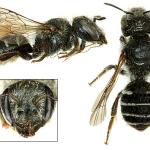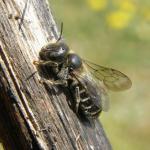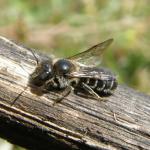This species was formerly misidentified by British authors as H. leucomelana (Kirby, 1802) (see Yarrow, 1970).
Widely distributed but usually uncommon throughout much of southern England and in south Wales (where it is largely coastal); much more sporadic in the Midlands, East Anglia and northern England. There are no records from Scotland, Ireland or the Channel Islands. Widely distributed throughout much of Europe, from Fennoscandia south to central Iberia, Corsica, Sardinia, and eastwards to Greece and Russia.
The species has been recorded from a wide range of habitats, including, for example, open broad-leaved woodland, heathland edge, chalk grassland and the coast.
Univoltine; late May to late August (rarely September).
Many nests of this bee have been found in dead stems, where the females had excavated the pith to form nesting burrows. Such stems included bramble, rose and ragwort. A nest has even been found in a buried bramble stem (Perkins, 1886). Other nest sites have been a buried, decaying root (Perkins, 1923); burrows in an old paling (Arnold, 1903); a burrow in the soil (Saunders, 1896); a small piece of dead pine branch lying on the ground (M Edwards, pers. comm.); and, on the Continent, an empty gall of the chloropid fly Lipara lucens on a reed stem (Blüthgen, 1919). The cells are separated from one another by partitions of leaf mastic, which is green when freshly made but later assumes a brownish-black colour. The inner surface of the nest burrow, rather than a layer of leaf mastic, forms the side walls of the cells. When full grown the larvae spin thin, semi-transparent silken cocoons in which the winter is passed; pupation takes place in the spring.
Buttercup, red clover, bird's-foot-trefoil, horseshoe vetch, heaths, field scabious, hawk's-beard and dandelion.
The cleptoparasitic megachiline bee Stelis ornatula has been reared on several occasions from British nests of H. claviventris. The ichneumon wasp Hoplocryptus bellosus has also been reared in this country from stem-nests of the Hoplitis (Danks, 1971, as H. signatorius).
1998




